Abstract
This article aims to implement new building standards for residential and industrial construction in Poland to protect against earthquakes. For more than 20 years, Europe has experienced an increasing number of earthquakes. Failure to prepare residential and industrial buildings for such an event can result in extensive damage, death, and injury. It is therefore reasonable to ask what losses Poland could suffer after even a single strong earthquake. An estimate of the losses after such an event is presented. It is crucial for many buildings and mines in Poland. It is also important to prepare the population for such an event. In addition, it is also crucial for many Central European countries, as governments have not received training on how to behave during an earthquake. The lack of such training could cause panic during such an event. Poland is rich in natural resources, with many coal and lignite mines. A strong earthquake can threaten these as well as residential, public, industrial, and other buildings. This article provides an overview of earthquake events in Europe in relation to events worldwide and proposes solutions based on the experience of other countries. Here is a proposal to prepare new standards for buildings in Poland for protection against earthquakes in the next 50 years, based on the experience of other countries.
1. Introduction
For many years, Poland, located in Central Europe, was considered an anti-seismic region, i.e., with a low risk of earthquakes. The last strong earthquake was felt in Warsaw, Lublin, and Bialystok in 1977, after a 7.2 M earthquake from Romania in the Vrancea seismic zone [1]. The energy of this event was transmitted through tectonic faults formed by the collision of tectonic plates, as discovered by Alfred Wagener [2], by seismic waves, including body waves, especially the S-wave and Love waves [3].
Every strong earthquake generates seismic waves [3] that carry energy and cause the neighboring tectonic plates to vibrate and move. These waves can carry accumulated vigor even to distant tectonic faults and can be released by the energy of a subsequent shock in the form of a single seismic shock. Therefore, seemingly unrelated to Europe, seismic shocks in distant regions are essential because the released energy is transferred and cumulative on tectonic plates adjacent to those that make up the European continent.
Poland lies on a European tectonic plate that touches the Aegean plate, the Anatolian plate, the Indian subcontinent, the Arabian subcontinent, the Chersky mountain range in eastern Siberia [4], and the African plate. The movement of the African plate to the north, after slowly descending under the Eurasian plate, the contact with the Eurasian plate with the Aegean Sea plate and the Anatolian plate [5,6] is the source of earthquakes.
In 2004, two strong earthquakes occurred in and around Poland (4.4 M and 5.2 M). The first was in September in the Kaliningrad region of Russia [7]. The authors of this work suggest applying this new standard to unique and monumental structures (e.g., nuclear power plants or large dams) [7]. The second earthquake in 2004 occurred in November in southern Poland [8].
Subsequent events in 2004 and 2017 have sparked a debate about whether the risk of earthquakes in Europe has increased. It was presented in Paris in 2013 [9]. Events in the following years confirmed these predictions.
On 26 December 2004, Indonesia [10] experienced one of the strongest earthquakes in the world, with a magnitude of 9.1 (Figure 1) [11]. It probably contributed to the change in the stability of the Indo-Australian plate and later the Arabian, African, and European plates.
From the turn of the year 2007 to 2008, several microearthquakes and increased CO2 emissions from the Laacher See (West Germany) were observed [12]. It is a dormant volcano with the last eruption 12,900 ± 560 years ago [13].
Later, in December 2008, strong earthquakes occurred in southern Sweden, which were felt in northern Poland [14]. The next one was in January 2010 near Bełchatów [7]. The last one was also in January 2010 near Jarocin [8]. In January of the following year, strong earthquakes occurred in Ukraine [8,15,16].
On 12 January 2010, a magnitude 7.0 earthquake occurred on the west side of the Europe-Asia plate in Haiti [17]. It was the source of tension between the Caribbean and North American plates. It changed the stiffness conditions on the west side of the African and Eurasiatic plates.
The motion of the North American plate may have been a source of activity for the volcano Eyjafjallajökull on Iceland from 20 March to 21 May 2010 [18]. Air travel between Europe and North America was affected in April and May 2010 [19].
On 1 July 2011, an eruption of the Nabro volcano in Ethiopia was observed [20]. After the earthquake, the Indian plate must have moved westward toward the African plate.
At the end of 2011, on 8 September, an earthquake of magnitude 4.5 occurred in the southern Netherlands (Goch, Dui) [20]. In January 2012, several new islands with active volcanoes were formed in the Red Sea [21].
Two more earthquakes of the same magnitude in Indonesia on 11 April 2012 [22] contributed to the theory that the Indo-Australian plate may break up [23].
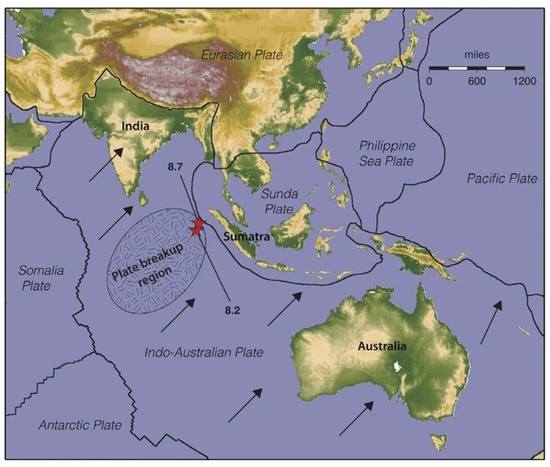
Figure 1.
Map showing earthquake from 25 December 2004 [24].
In mid-2013, a new geyser volcano led to the closure of the Fiumicino airport in Rome [25]. From October 2016 to the present, Italy has experienced a series of strong earthquakes (from 4.6 to 7.1 mag.) in the central part of the country. Many buildings collapsed, people were injured, many lost their homes, and several died. Some parts of the mountains plunged to 0.7 m. Many of these buildings were built with traditional materials and methods that were not resistant to earthquakes [26].
Later in 2018, it was confirmed that another tectonic plate, the Cocos plate, located on the western side of Central America, broke under solid earthquakes in September 2017 in Mexico (Figure 2) [27,28]. It is crucial because the Mid-Atlantic Ridge is connected to the European tectonic plates.
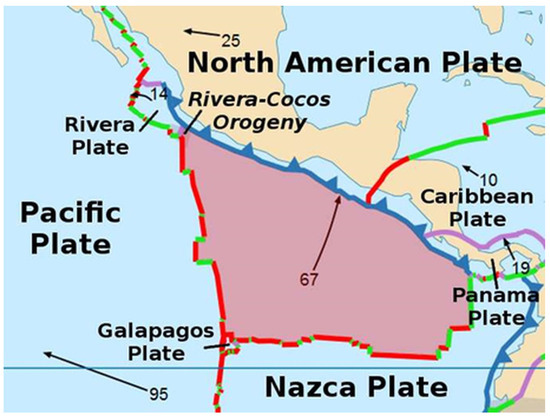
Figure 2.
Map showing the place of breakage of the Cocos plate [27,28].
Later, in November 2019, several earthquakes occurred in Albania, with the highest magnitude of 6.4. This event damaged several hundred houses and killed more than 50 people (Figure 3) [29].
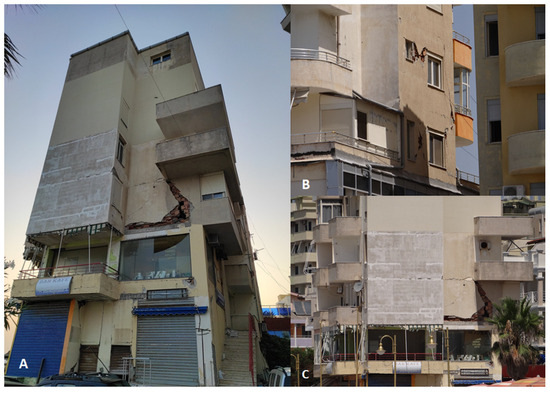
Figure 3.
(A–C) Damaged buildings in Albania on 26 November 2019 after earthquakes of magnitude 6.4 [30].
On 29 December 2020, a strong 6.4 magnitude earthquake struck the Croatian capital of Zagreb. It caused considerable damage to buildings and infrastructure [31].
On 7 February 2023, a 7.7 magnitude earthquake in Turkey destroyed many residential areas. Many medium and strong earthquakes still confirm that the Arabian subcontinent is moving to the northwest [32].
On 23 March 2023, 18:08:57.0 UTC, a weak earthquake with a magnitude of 2.5 and a depth of 10 km occurred on the Polish-Belarusian-Ukrainian border. It is significant because it is located between the Polish and Ukrainian coal mining regions [32].
On 30 March 2023, 20:26:13.3 UTC, a magnitude 4.0 earthquake with a depth of 10 km occurred in Austria, 54 km SSW of Favoriten, Austria [32].
It should be an inspiration for future governments of countries in Central Europe.
2. Risk of Earthquakes in Central Europe
The introduction states that Poland has been considered a seismic region for years [33,34]. This is confirmed by the 2003 map (Figure 4) [35]. In 2010, Poland experienced a strong earthquake in a region without mines; older quakes are also known (Figure 5). In 2013, a meeting of seismologists and geologists was held in Paris [36,37,38] (Figure 6). Later, there was a new opinion in 2020, Figure 7 [38]. It is connected to seismic faults in southern Europe. These faults can store energy from previous earthquakes and release the energy stored as new earthquakes, Figure 8 [39].

Figure 4.
SESAME map from 2003 for a 90% nonexceedance probability within 50 years [34].
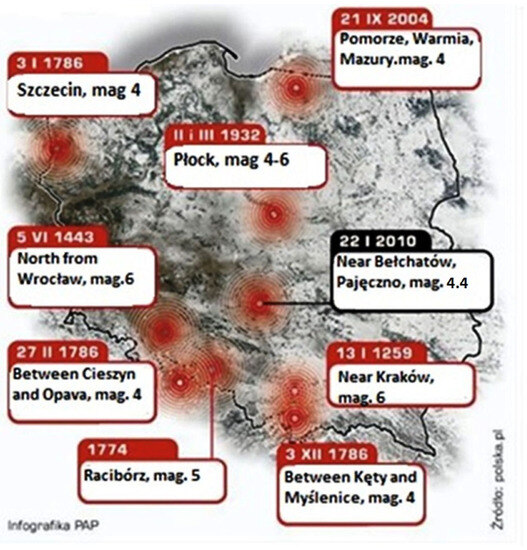
Figure 5.
Regions of Poland where large earthquakes occurred between the 13th and 21st centuries [8].
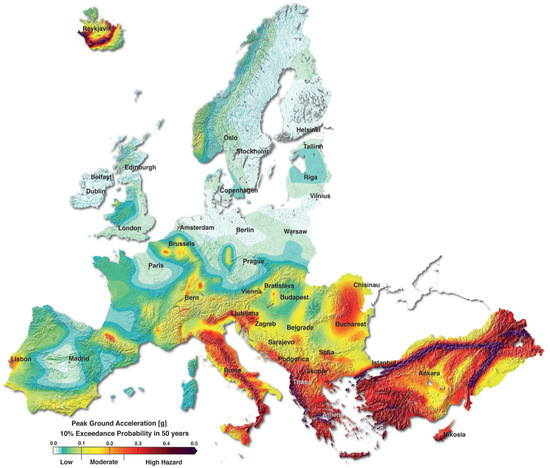
Figure 6.
European seismic hazard map for 2013 [37].
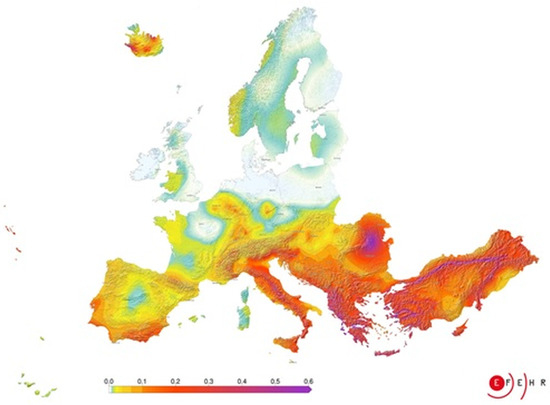
Figure 7.
European seismic hazard map for 2020 [38].
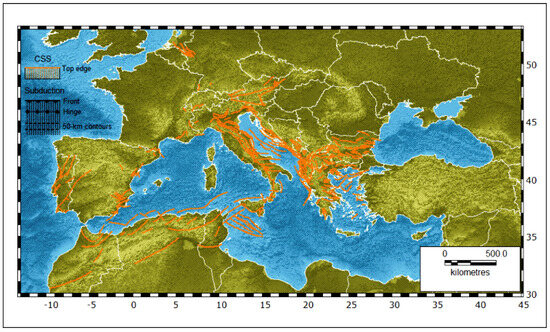
Figure 8.
Map of seismogenic faults in Southern Europe [40].
It completely changes the current view of the risk of a strong earthquake in Central Europe, especially in Poland.
The greatest threat to Central and Eastern Europe is the Vrancea seismic zone (Figure 9 and Figure 10). It is the source of the largest earthquake in the region that can affect Poland. This zone is located in southern Romania in the Carpathian Mountains and is defined by the coordinates 45.6° N and 46.0° N and the longitudes 26.5° E and 27.5° E. It has experienced some of the strongest earthquakes recorded in the last 100 years: 10 November 1940, Mw = 7.7, H = 150 km; 4 March 1977, Mw = 7.4, H = 94 km; 30 August 1986, Mw = 7.1, H = 131 km; 30 May 1990, Mw = 6.9, H = 91 km; 31 May 1990, Mw = 6.4, H = 87 km; 27 October 2004, Mw = 5.9, H = 96 km [39,41] and were felt in Central and Eastern Europe, including Poland, within the borders of 1939 or 1945, after World War II. It is the meeting point of the Moesian, Intra-Alpine, and Carpathian accretionary wedges. The movement of the Moesian plate beneath the Intra-Alpine plate creates a seismic zone where any movement creates a stress regime capable of generating thrust fault earthquakes [42].
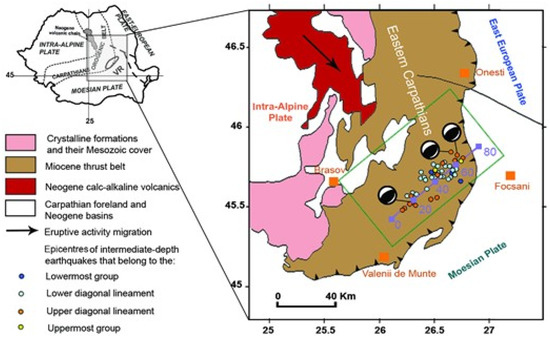
Figure 9.
The geological structure of the Vrancea seismic zone [43].
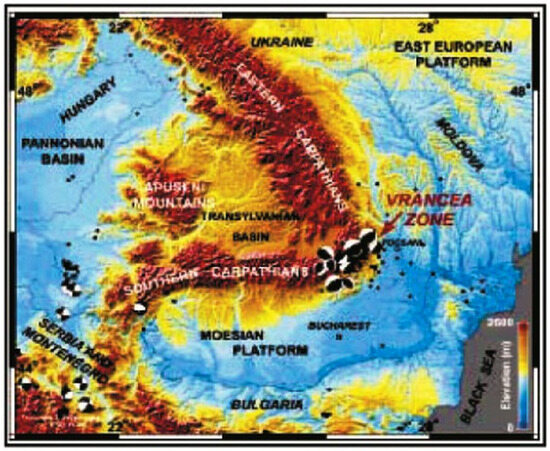
Figure 10.
Localization of the Vrancea seismic zone in Romania [44].
This zone was formed more than 2 billion years ago when it met the three central tectonic provinces of Europe, known as the Paleoproterozoic East European Craton (EEC); the Paleozoic Platform of Central and Western Europe (PP), represented by its TESZ (Trans-European Suture Zone; Domain); and the Meso-Cenozoic Carpathian fragment of the vast Alpine-Himalayan organic system. In places of contact with the Vrancea seismic zone mentioned above and the Teisseyre–Tornquist zone (TTZ), which runs through the whole of Poland (Figure 11), western Ukraine, and Moldova, from the Baltic Sea to the Black Sea, Figure 12 [45].
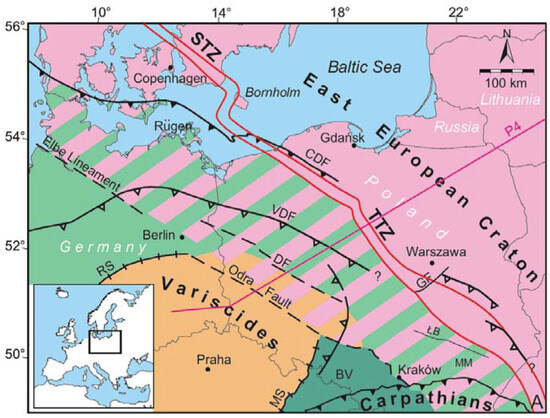
Figure 11.
Teisseyre–Tornquist zone and Odra fault line in Poland [46].
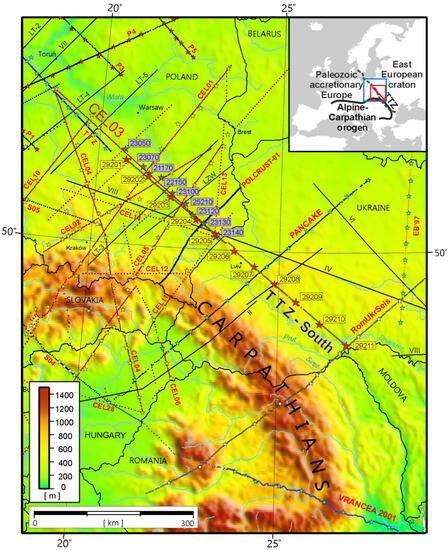
Figure 12.
Location of the southern part of the Teisseyre–Tornquist zone (TTZ) [45].
The maps in Figure 6 and Figure 7 do not include countries outside the European Union. Therefore, the seismic hazard map for the entire Carpathian macroregion of Moldova and Ukraine in Figure 13 and Figure 14 is worth mentioning. It shows that the Carpathian arc is threatened by earthquakes [45,47,48]. Furthermore, it is crucial because the Carpathian arc is located in Romania, Ukraine, Slovakia, Czech Republic, and Poland, see Figure 10. If a strong earthquake occurs in the Vrancea seismic zone, Figure 9 and Figure 10, the seismic waves can propagate, Figure 12 and Figure 13, to the Teisseyre–Tornquist zone (TTZ), Figure 12, located in Moldavia, Figure 13, and transfer the energy of this quake to central Poland, Figure 9, and also through the Odra fault line, Figure 11, to the southern region of Poland. This new analysis for 2013 [35] and 2020 [38] could be very important for critical infrastructure in Europe. It suggests that the view of the seismic safety of existing buildings should be changed.
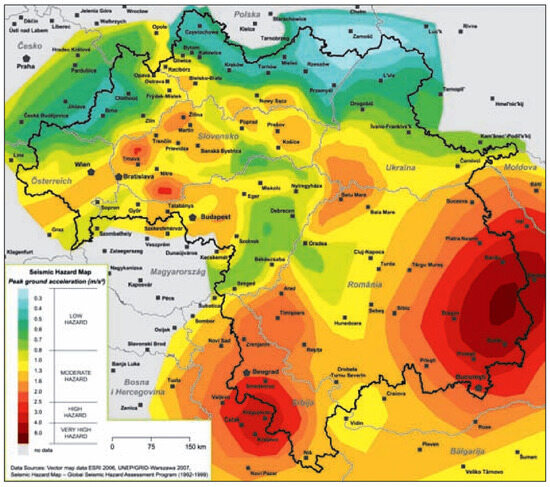
Figure 13.
Seismic hazard map of the Carpathian macroregion [47].
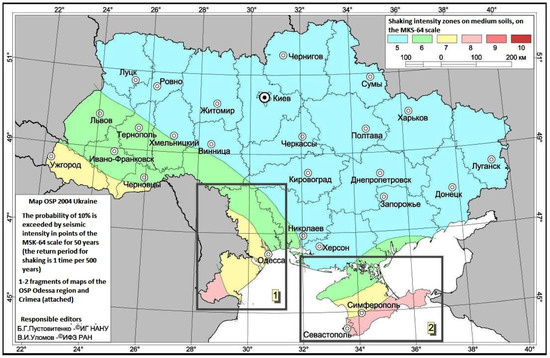
Figure 14.
Map of Seismic Zones in Ukraine [48].
There is a high probability of earthquakes in Central Europe (Czech Republic, Slovakia, Hungary, Slovenia, Croatia, Serbia, the former Republic of Macedonia, Albania, Romania, and Bulgaria). There is also a higher risk for the western part of Ukraine and Moldova. The risk is negligible for the Baltic countries of Latvia and Estonia. All southern European countries have a higher risk of significant earthquakes than in 2003.
The North Sea–Mediterranean Core Network Corridor and the Rhine–Alpine Core Network Corridor lie on a newly identified seismically active zone along the eastern border of France.
This map (Figure 6, Figure 7 and Figure 13) shows that the probability of earthquakes in Central and Eastern Europe changes by more than 10%. All of Poland, from east-south to west-north, is a line of the higher probability for earthquakes. This area is covered by the Teisseyre–Tornquist Zone substructure (Figure 15).
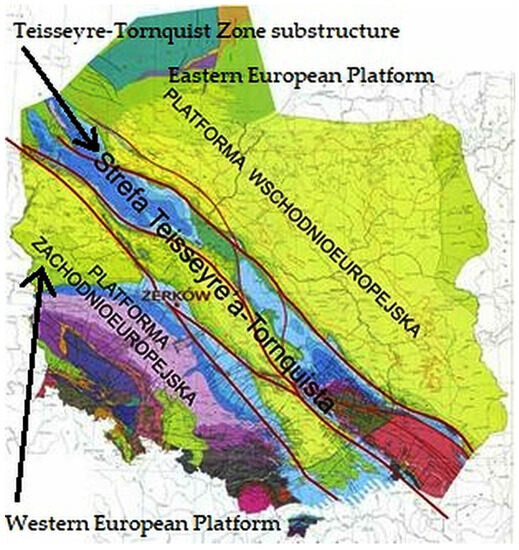
Figure 15.
Background of the Polish geological map without Cenozoic formation [49].
The Polish geologist Wawrzyniec Teisseyre discovered this zone, and his research has confirmed that of the German Alexander Tornquist [49].
The fundamental question is: Was another critical infrastructure for the Polish economy—railways, roads, power grids, and pipelines—designed to be earthquake resistant?
All current structures were built when the territory of Poland was considered a seismic zone. It suggests a change in the approach to protecting these structures against earthquakes.
3. Methodology
Based on the information about earthquakes, it is necessary to analyse the risk scenario for Poland. Each earthquake can destroy part of the infrastructure, including buildings, highways, and railways. The damage depends on the depth and magnitude of the quake: the strongest with a magnitude of M >= 5 begins to cause damage. The shallower it is, the greater the surface damage. It also depends on the strength of the construction. The poorer the construction, the poorer the materials used, or the wrong design solutions, the greater the risk of damage. Even a magnitude 4 can cause significant damage to weak bindings in a tiny area around the epicenter. A magnitude 3 quake can be felt as a weak tremor at the epicenter (if it is shallow) and cannot cause damage to anything. M = 2 earthquakes occur all over the world, but are only felt by nearby seismic instruments.
What is the situation in Poland with respect to each of these factors?
- −
- The seismic hazard is certainly not increasing. It is just that we are increasing our knowledge of fault systems, and as humans we have had a very short observation time compared to geological times, and therefore we have certainly missed several past events. We must consider the risk of earthquakes as part of the risk scenario for the socio-ecological system of the historical areas, namely: the built environment; the natural environment; the economic dimension; the social dimension; the cultural dimension (both tangible and intangible); and the political dimension, Table 1.
 Table 1. The Risk Scenario Prioritization Tool [50].
Table 1. The Risk Scenario Prioritization Tool [50]. - −
- Exposure may be higher (e.g., densely populated areas; highly interdependent critical infrastructures) where the loss of one could lead to the loss of others (e.g., telecommunications); high-value and vulnerable industries (e.g., high technology).
- −
- The vulnerability of buildings and infrastructures may be high (because they were designed without consideration of seismic design codes) and may increase as buildings age and require structural retrofitting.
Seismic risk is not considered a priority in Poland. In order to persuade actions and policies to prepare for and mitigate impacts, it may be necessary to propose a multi-hazard and multipurpose action (e.g., preparedness for seismic events as part of a multi-hazard preparedness campaign that also touches on extreme weather events, pandemics, seismic retrofitting as part of energy efficiency renovations, and others).
4. Results and Discussion
Assume a priori. One day there will be a strong earthquake in Poland. We cannot predict exactly where and when it will occur. We can assume that it will happen in the regions marked on the maps with increased risk from the year 2000. Based on the history of earthquakes in Poland [8], we can see that the strongest will be about magnitude 6.0, closer to the surface with a depth of 10 km, where there are concentrations of several fault lines of the Teisseyre–Tornquist zone and the southern regions of Poland in the Odra fault line (see Figure 11). This quake generates most of the damage caused by body waves, especially the S and Love waves [3]. The map prepared by GEM shows the hazard risk for each region of Poland (Figure 16). In it, we can see that in Poland the risk of earthquakes is located in the central and southern voivodeships, the so-called Podkarpacie, Małopolska and Śląskie, Opolskie, Dolnośląskie, Lubelskie, Świętokrzyskie and Mazowieckie.
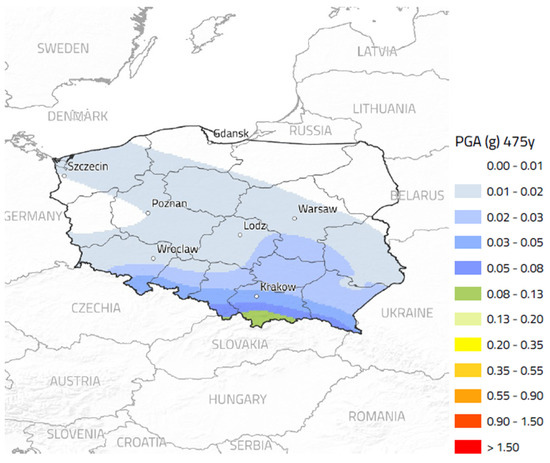
Figure 16.
Seismic hazard for regions in Poland [51].
It is related to the geological Polish thigh. This map, Figure 17, shows that the most vulnerable regions are in the Polish Lowlands and any region with mountains. The Polish Lowlands is an extensive Permo-Mesozoic Polish unconformable basin, covered by a Cenozoic sedimentary sequence up to 350 m thick. The thickness of the Permo-Mesozoic strata varies from about 1 km near the Odra fault zone in the south to more than 4 km north of Poznan and about 8 km further north [52].
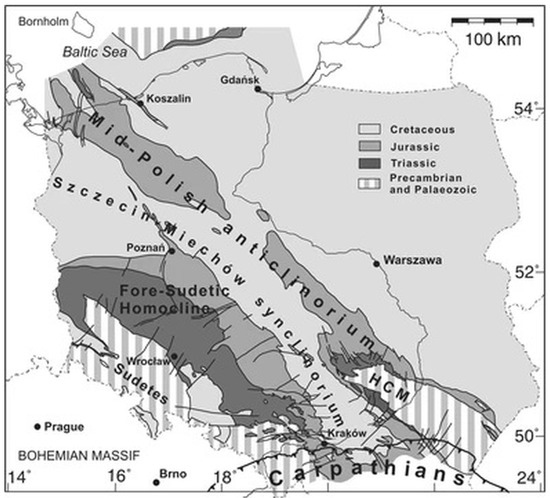
Figure 17.
The shallow geology of Poland [52].
The following question arises: What could be the losses for the Polish economy after this event?
For this analysis, we will use the map of average annual losses for each region of Poland (Figure 18).
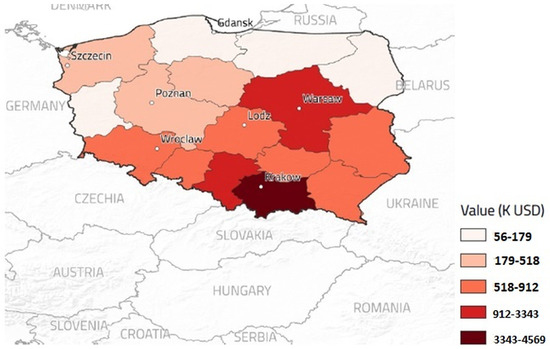
Figure 18.
Map of the average annual losses in Poland [51].
They used seismic microzonation to divide a region into smaller areas with different potentials for hazardous earthquake effects in Poland. It is assumed that the effects of earthquakes depend on the geomorphological characteristics of the ground, consisting of geological, geomorphological, and geotechnical information [53].
Data from historical earthquakes (Figure 5) and current observations (Figure 6 and Figure 7) of such events are essential. They allow the identification of regions that have been threatened by earthquakes in the past and the identification of the causes of current changes, Table 2.

Table 2.
Use of data for three levels of zonation [54].
Therefore, not only what is on the ground but also what is underground is essential to calculate potential losses in an earthquake.
It can be seen that regions with a thin cover of the Cenozoic sedimentary sequence are the most threatened. These are the regions of the Carpathians, the Sudetes, the Swie-tokrzyskie Mountains, the Silesian Uplands, the Lublin Uplands, and the Łódź Uplands. Mazowieckie was also at risk because it is a city where many strategic offices of the Polish state are located. For this reason, the risk of an earthquake was included in the calculations.
This proposal was analysed using an EMV (expected monetary value) method [55]. In the classic analysis of the EMV method, a positive and a pessimistic scenario are used. Not every earthquake can have a positive impact. It is necessary to change the understanding of the scenarios taken as results of the simulation of the EMV method. It has been suggested to call the first scenario “weak losses” and the second scenario “large losses”.
According to [51], the losses were calcified after the earthquakes. Updated prices [56], and seismic hazard ratios were used for regions in Poland, and the ratios were changed for Lower Silesia, Lublin, Łódz, Lesser Poland, Mazowieckie, Opolskie, Podkarpackie, Upper Silesia, Greater Poland, and West Pomeranian Voivodeships. The results are presented in Table 3.

Table 3.
The loss suffered in Poland after the earthquake.
Any magnitude 6 quake at a shallow depth, about 10 km underground, will cause extensive surface damage. It will affect all buildings that were not designed with earthquake resistance in mind. Buildings made of masonry, including bricks and stone, will be particularly affected. The same is true for large slab buildings. The effects of demolishing residential buildings after an earthquake can be seen in pictures from Turkey. On 7 February 2023, a 7.7 magnitude earthquake occurred. Many buildings that were built in-situ with cast concrete and assembled with prefabricated concrete elements collapsed.
In Poland, such an earthquake can destroy chimneys and halls of the largest power plant in Bełchatów: highways and railroads from the south to the north of Poland. The shutdown of the Bełchatów power plant alone will cost the Polish economy PLN 50 billion (USD 11,561.50 [57]) per day.
Surface damage will be negligible if the epicenter of the earthquake is deeper than 30 km. It propagates seismic waves with a force of about 5.0 on the Richter scale and can carry shock energy that can be strong enough to damage the structure of buildings. Mining activities in Silesia and the Lublin region can cause several strong tremors. It can kill people. In many countries, structural nodes are used, for example, based on the Ukrainian antiseismic standard DBN B. 1.1-12:2006 “Construction in seismic regions of Ukraine” of the connections of structural elements, Figure 19 [48].
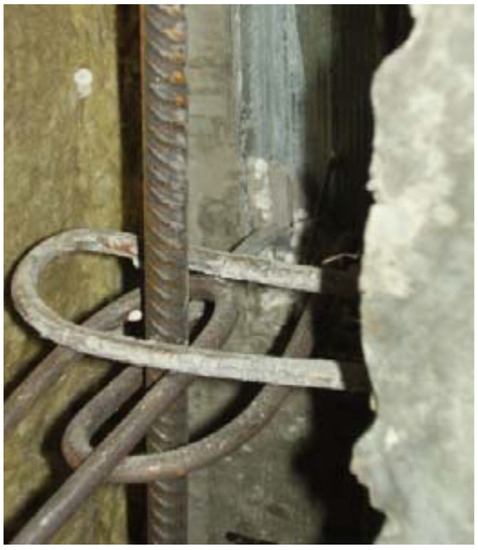
Figure 19.
Hinged joint [48].
If the epicenter is refunded, the surface damage may be less.
A magnitude of 4.0 on the Richter scale with an external shock can damage buildings and contribute to the collapse of those with low resistance.
If the epicenter is much lower, the surface damage may be less. It is also important to prepare the population for such an event. For this purpose, a similar information poster should be promoted and displayed in public places, as is the case in the state of California in the USA (Figure 20).
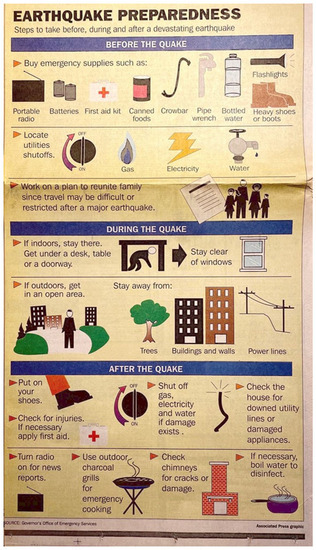
Figure 20.
Preparations and behavior during an earthquake, a 1994 poster [58].
It is also based on the Chilean training scenario called Daisy. It starts in kindergarten, where children are trained to hide under tables or beds in case of an earthquake. Adults know: every day it is necessary to turn off the main gas valve in the house, and during an earthquake to extinguish a cigarette, all furniture should be mounted on the walls and vases should not be placed on high furniture [59].
Below a magnitude of 3.0, it can be felt and cause minor damage, such as cracks in the walls. The amount of shaking felt depends on the distance from the epicenter and the depth below the surface. The movement of the earth can be felt in many homes.
What could be the cause of these significant losses?
It is suggested that the source is based on the opinion that the Poland region is seismic. It means that many buildings and mines can be damaged because the current Polish construction standards do not propose to protect these structures against horizontal movements of the ground. In the 1950s and 1960s, many public buildings were built to protect them from air raids. This was the height of the Cold War. Since the 1980s, the construction of buildings with this type of unique design has been halted.
5. Conclusions
According to a 2007 opinion, Poland and other Central European countries should start training the population on how to behave in the event of an earthquake. This could be done in three stages.
The first could be based on the same training scenario used for many years in Japan and other countries with high seismic activity.
The second could be based on the Chilean training scenario called Daisy. We must train people how to behave at the time of an earthquake, as in the United States (Figure 20).
The third step could be based on the proposal of the authors of the 2007 paper on the introduction of building resistance in Poland according to the Eurocode 8 standard. The seismic zone of Eurocode 8 should be implemented for building standards in Central and Eastern Europe, such as Ukraine (Figure 19). Today, seismic activity is changing. For many years, the opinion about the possibility of a significant earthquake in Central Europe has been based on the conclusion that earthquakes occur far away from Europe.
It is advisable to use the well-known LIDAR solution to scan the changes on the Earth’s surface after each strong earthquake, more than a magnitude 5. This will allow you to check for displacements that are critical for infrastructure such as transportation. For example, data on European seismic activity will be collected over the next five years in the field of seismology and as a basis for an initiative on new building standards for the European Union.
If the number of earthquakes increases, a standard for the protection of critical infrastructure should be introduced. In the case of Poland, a new analysis shows that the opinion from 2007 should be extended to land transport infrastructure, mines, telecommunications, and energy networks in the southern regions. In Poland, where many houses are built with the same or similar technology as in Albania, a strong earthquake can cause significant economic damage and losses, even more so after the great flood of 1997. The country is not prepared for such an event.
Funding
This research received no external funding.
Institutional Review Board Statement
Not applicable.
Informed Consent Statement
Not applicable.
Data Availability Statement
Not applicable.
Conflicts of Interest
The author declares no conflict of interest.
References
- Dziennik Polski. Fala Wstrząsów Sejsmicznych w Europie, Katast, Rofalne Trzęsienie Ziemi w Rumunii. 6. Dziennik Polski. nr 52 (7 III) (7 March 1977) = nr 10225. 1977. Available online: http://mbc.malopolska.pl/dlibra/applet?mimetype=image/x.djvu&sec=false&handler=djvu_html5&content_url=/Content/61285/index.djvu (accessed on 14 August 2023).
- Wegener, A. Die Entstehung der Kontinente und Ozeane; Druck und Verlag von Friedr. Vieweg & Sohn r: Braunschweig, Germany, 1929; p. 18. [Google Scholar]
- Shearer, P.M. Introduction to Seismology; Cambridge University Press: Cambridge, UK, 1999; ISBN 0521-66953-7. [Google Scholar]
- Lovett, R.A. Europe Starting to Dive Under Africa? National Geographic News. 19 April 2011. Available online: http://news.nationalgeographic.com/news/2011/04/110419-europe-africa-mediterranean-earthquake-risk-increasing-earth-science/ (accessed on 30 November 2015).
- Bird, P. An Updated Digital Model of Plate Boundaries. Geochem. Geophys. Geosyst. 2003, 4, 1–52. [Google Scholar] [CrossRef]
- Baes, M.; Govers, R.; Wortel, R. Subduction initiation along the inherited weakness zone at the edge of a slab: Insights from numerical models. Geophys. J. Int. 2011, 184, 991–1008. [Google Scholar] [CrossRef]
- Zembaty, Z.; Wiejacz, P. Is there a need for seismic code in Poland? Wydawnictwo Politechniki Krakowskiej im. Tadeusza Kościuszki. Czasopismo Techniczne. Budownictwo, 2007; R. 104, z. 2-B, pp. 127–134. Available online: https://repozytorium.biblos.pk.edu.pl/redo/resources/34687/file/suwFiles/ZembatyZ_PolscePotrzebna.pdf (accessed on 14 August 2023).
- Trzęsienia Ziemi na Ziemiach Polskich. Available online: https://pl.wikipedia.org/wiki/Trz%C4%99sienia_ziemi_na_ziemiach_polskich (accessed on 30 November 2021).
- Leboussi, C. Des Séismes sans Précédent Historique Sont Possibles en Europe. LE MONDE. 16 August 2013. Available online: http://www.lemonde.fr/planete/article/2013/08/16/des-seismes-sans-precedent-historique-sont-possibles-en-europe_3462489_3244.html?xtmc=vibrations_du_sol&xtcr=2 (accessed on 30 November 2015).
- Lay, T.; Kanamori, H.; Ammon, C.; Nettles, M.; Ward, S.; Aster, R.; Beck, S.; Bilek, S.; Brudzinski, M.; Butler, R.; et al. The Great Sumatra-Andaman Earthquake of 26 December 2004. Science 2005, 308, 1127–1133. [Google Scholar] [CrossRef] [PubMed]
- USGS: US Geological Survey. Magnitude 9.1–Off the West Coast of Northern Sumatra. 26 December 2004. Available online: https://earthquake.usgs.gov/earthquakes/eventpage/official20041226005853450_30/executive (accessed on 14 August 2023).
- Pogoda, T. Potężne Trzęsienia Ziemi w Polsce Rujnowały Całe Miasta. Available online: http://www.twojapogoda.pl/wiadomosci/114040,potezne-trzesienia-ziemi-w-polsce-rujnowaly-cale-miasta (accessed on 30 November 2015).
- Giggenbach, W.; Sano, Y.; Schmincke, H. CO2-rich gases from Lakes Nyos and Monoun, Cameroon; Laacher See, Germany; Dieng, Indo-nesia, and Mt. Gambier, Australia—Variations on a common theme. J. Volcanol. Geotherm. Res. 1991, 45, 311–323. [Google Scholar] [CrossRef]
- Gal, F.; Michel, B.; Gilles, B.; Frédéric, J.; Karine, M. CO2 escapes in the Laacher See region, East Eifel, Germany: Application of natural analogue onshore and offshore geochemical monitoring, Of shore geochemical monitoring. Int. J. Greenh. Gas Control 2011, 5, 1099–1118. [Google Scholar] [CrossRef]
- GFZ: (Helmholtz-Zentrum Potsdam-Deutsches GeoForschungsZentrum) GFZ: Earthquake Info: Origin TimeUTC 2015-02-03 05:56:30, Mag 4.5, Latitude Degrees 50.65°N, Longitude Degrees 34.22°E, Depth km 10, Alert Classification Criteria M, Flinn-Engdahl Region Name Ukraine. 2015. Available online: https://geofon.gfz-potsdam.de/eqinfo/event.php?id=gfz2015citj (accessed on 30 April 2023).
- Vervaeck, A. Slightly Damaging Earthquake in Ukraine, 3 February, 2015 at 5:38 pm. Available online: http://earthquake-report.com/2015/02/03/moderate-earthquake-balticsbelarusnorthwestern-russia-reg-on-february-3-2015/ (accessed on 30 November 2015).
- Miyamoto, H.K.; Gilani, A.S.J.; Wong, K. Massive Damage Assessment Program and Repair and Reconstruction Strategy in the Aftermath of the 2010 Haiti Earthquake. Earthq. Spectra 2011, 27, 219–237. [Google Scholar] [CrossRef]
- Bye, B.L. Volcanic Eruptions: Science and Risk Management; Science 20.com: Folsom, CA, USA, 2011; Available online: https://www.science20.com/planetbye/volcanic_eruptions_science_and_risk_management-79456 (accessed on 14 August 2023).
- Carlsen, H.K.; Hauksdottir, A.; Valdimarsdottir, U.A.; Gíslason, T.; Einarsdottir, G.; Runolfsson, H.; Briem, H.; Finnbjornsdottir, R.G.; Gudmundsson, S.; Kolbeinsson, T.B.; et al. Health effects following the Eyjafjallajökull volcanic eruption: A cohort study. BMJ Open 2012, 2, e001851. [Google Scholar] [CrossRef] [PubMed]
- Dunphy Mark: Nabro Volcano Eruption Resumes. TesfaNews. 1 July 2011. Available online: https://www.tesfanews.net/nabro-volcano-eruption-resumes/ (accessed on 30 November 2015).
- The Netherlands Could Experience 7.0M Earthquake, Soon Netherlands Is Earthquake Waiting, 10-9-11. Available online: https://www.ad.nl/ad/nl/1012/Binnenland/article/detail/2901358/2011/09/10/Nederland-staat-zware-aardbeving-te-wachten.dhtml (accessed on 30 November 2015).
- A Hot New Island Has Just Surfaced in the Red Sea. What’s Going On? Smithsonian Scientists Explain. Earth Science, Marine Science, Science & Nature. 11 January 2012. Available online: https://insider.si.edu/2012/01/a-hot-new-island-has-just-popped-up-in-the-red-sea-what-is-going-on-smithsonian-scientists-explain/ (accessed on 30 November 2015).
- Wiens, D.A.; Stein, S.; Demets, C.; Gordon, R.G.; Stein, C. Plate tectonic models for Indian Ocean “intraplate” deformation. Tectonophysics 1986, 132, 37–48. [Google Scholar] [CrossRef]
- Shen, H. Unusual Indian Ocean Earthquakes Hint at Tectonic Breakup; April 2012 Quakes Occurred Away from Plate Edges, Suggesting Formation of a New Boundary; Nature Publishing Group: Berlin, Germany, 2012; Available online: https://www.nature.com/news/unusual-indian-ocean-earthquakes-hint-at-tectonic-breakup-1.11487 (accessed on 30 November 2015).
- Kington, T. Volcanic ‘Geyser’ Erupts Close to Rome Airport, Fiumicino. The Telegraph. 25 August 2013. Available online: https://www.telegraph.co.uk/news/worldnews/europe/italy/10265372/Volcanic-geyser-erupts-close-to-Rome-airport.html (accessed on 30 November 2015).
- Calder, S.; Italy Earthquakes: Why the Country Gets So Many of Them, and How To Survive One. The Independent, 20 January 2017. Available online: https://www.independent.co.uk (accessed on 30 April 2017).
- Andrews, R.G. Robin George Andrews: Quake Split a Tectonic Plate in Two, and Geologists are Shaken, An Intense Temblor in Mexico Was Just the Latest Example of an Enigmatic Type of Earthquake with Highly Destructive Potentia. National Geographic. 24 October 2018. Available online: https://www.nationalgeographic.com/science/2018/10/news-tectonic-plate-split-earthquakes-tsunamis-geology/ (accessed on 30 November 2018).
- Dapcevich, M. Mexico’s Huge 2017 Earthquake Split a Tectonic Plate in Two, Baffling Geologists, 25 October 2018, 12:11. Available online: https://www.iflscience.com/environment/mexicos-huge-2017-earthquake-split-a-tectonic-plate-in-two-baffling-geologists/ (accessed on 30 November 2018).
- Vila Janula: Shuarja e 51 Jetëve, orët e Ankthit dhe Shpresa për t’i Gjetur Gjallë, Historitë Tronditëse të 26 Nëntorit, Lëkundjet që Shuan Shumë Ëndërra (alb.). dosja.al, 2019-12-29 29 Dhjetor, 2019 14:00. Available online: https://dosja.al/dosja-termeti-shuarja-e-51-jeteve-oret-e-ankthit-dhe-shpresa-per-ti-gjetur-gjalle-historite-tronditese-te-26-nentorit-lekundjet-qe-shuan-shume-enderra/ (accessed on 30 November 2020).
- Wolniewicz, Ł. Email from, 7 September 2021, 09:29, with Agreement for Free Publishing. email accessed on 7 September 2021.
- University of Zagreb, 2020: Potresi Kod Petrinje u Razdoblju od 28.12.2020. u 06:28 do 31.12.2020. u 17:00 [Earthquakes Near Petrinja in the Period between 2020-12-28 06:28 and 2020-12-31 17:00]. Seismological Survey of Croatia, Faculty of Science, University of Zagreb. 31 December 2020. Available online: https://www.pmf.unizg.hr/geof/seizmoloska_sluzba/izvjesca_o_potresima?@=1m69w (accessed on 7 September 2021). (In Croatian).
- EMSC: (European-Mediterranean Seismological Centre (EMSC). Available online: http://www.emsc-csem.org/Earthquake/earthquake.php?id=425578 (accessed on 31 March 2023).
- PAP. Naukowcy: Polsce nie Grożą Silne Trzęsienia Ziemi, 25 January 2010. Available online: https://naukawpolsce.pap.pl/aktualnosci/news,369665,naukowcy-polsce-nie-groza-silne-trzesienia-ziemi.html (accessed on 30 November 2015).
- Giardini, D.; Grünthal, G.; Shedlock, K.M.; Zhang, P. The GSHAP Global Seismic Hazard Map. In International Handbook of Earthquake & Engineering Seismology; International Geophysics Series 81 B; Lee, W., Kanamori, H., Jennings, P., Kisslinger, C., Eds.; Academic Press: Amsterdam, The Netherlands, 2003; pp. 1233–1239. [Google Scholar]
- Niedźwiecki, M. Struktura Ziemi, Astronet.pl. Opublikowany: 2008-10-9 14:45, adk.astronet.pl/images/Plates_tect.jpg. 2008, accessed on 30 November 2015.
- GEM: GEM Foundation: Leveraging on Unique Synergies and Findings in Europe. 2013. Available online: https://www.globalquakemodel.org/what/regions/europe/ (accessed on 30 November 2015).
- SHARE: Seismic Hazard Harmonization in Europe, European Seismic Hazard Map 2013. Available online: https://www.share-eu.org/sites/default/files/Figure1.mean_SA%5B000%5D_RP475_arranged_550_360.png (accessed on 30 November 2015).
- Danciu, L.; Nandan, S.; Reyes, C.; Basili, R.; Weatherill, G.; Beauval, C.; Rovida, A.; Vilanova, S.; Sesetyan, K.; Bard, P.-Y.; et al. The 2020 Update of the European Seismic Hazard Model: Model Overview. EFEHR Technical Report 001, v1.0.0. Available online: http://hazard.efehr.org/en/Documentation/specific-hazard-models/europe/eshm2020-overview/ (accessed on 14 August 2023).
- Basili, R.; Kastelic, V.; Demircioglu, M.B.; Garcia Moreno, D.; Nemser, E.S.; Petricca, P.; Sboras, S.P.; Besana-Ostman, G.M.; Cabral, J.; Camelbeeck, T.; et al. The European Database of Seismogenic Faults (EDSF) Compiled in the Framework of the Project SHARE. Available online: https://seismofaults.eu/edsf13 (accessed on 31 March 2023).
- efehr.org: EARTHQUAKE RISK across Europe. What Effects Should We Expect from Future Earthquakes in Europe? The efehr.org Website Is Maintained and Hosted by the Swiss Seismological Service (SED) at ETH Zurich, in Collaboration with GEM (Global Earthquake Model Foundation) and EPOS (European Plate Observing System). Available online: http://www.efehr.org/explore/Downloads-information-material/ (accessed on 30 November 2015).
- Ardeleanu, L.; Leydecker, G.; Bonjer, K.-P.; Busche, H.; Kaiser, D.; Schmitt, T. Probabilistic seismic hazard map for Romania as a basis for a new building code. Nat. Hazards Earth Syst. Sci. 2005, 5, 679–684. [Google Scholar] [CrossRef]
- Oth, A.; Wenzel, F.; Radulian, M. Source parameters of intermediate-depth Vrancea (Romania) earthquakes from empirical Green’s functions modelling. Tectonophysics 2007, 438, 33–56. [Google Scholar] [CrossRef]
- Mitrofan, H.; Anghelache, M.-A.; Chitea, F.; Damian, A.; Cadicheanu, N.; Vişan, M. Lateral detachment in progress within the Vrancea slab (Romania): Inferences from intermediate-depth seismicity pat-terns. Geophys. J. Int. 2016, 205, 864–875. [Google Scholar] [CrossRef]
- Zoran, M.A.; Savastru, R.S.; Savastru, D.M. Savastru: Satellite thermal infrared anomalies associated with strong earthquakes in the Vrancea area of Romania. Open Geosci. 2015, 7, 606–617. [Google Scholar] [CrossRef]
- Janik, T.; Starostenko, V.; Aleksandrowski, P.; Yegorova, T.; Czuba, W.; Środa, P.; Murovskaya, A.; Zayats, K.; Mechie, J.; Kolomiyets, K.; et al. Lithospheric Structure of the East European Craton at the Transition from Sarmatia to Fennoscandia Interpreted from the TTZ-South Seismic Profile (SE Poland to Ukraine). Minerals 2022, 12, 112. [Google Scholar] [CrossRef]
- Grad, M.; Guterch, A.; Mazur, S. Seismic Refraction Evidence for Crustal Structure in Central Part of the Trans-European Suture Zone in Poland; Winchester, J.A., Pharoah, T.C., Verniers, J., Eds.; Paleozoic Amalgamation of Central Europe; Geological Society of London Special Publication: London, UK, 2022; Volume 201, pp. 295–309. [Google Scholar]
- Ptáček, P.; Létal, A.; Ruffini, F.V.; Renner, K. Atlas of the Carpathian Macroregion. Eur. Reg. 2009, 17, 108–122. [Google Scholar]
- Nemchynov, I.; Kryvosheyev, P.; Khavkin, A.; Maryenkov, N.; Babik, K.; Dorofyeyev, V.; Yegupov, K.; Murashko, A.; Zolotaryov, I.; Kukunayev, V.; et al. Seismic Hazards in Ukraine, Investigation Experience and Earthquake Engineering Development Tasks. In Proceedings of the 15th World Conference on Earthquake Engineering Conference Venue: Proceedings of the 15th World Conference on Earthquake Engineering, Lisbon, Portugal, 24–28 November 2012. [Google Scholar]
- PGI: The Polish Geological Institute-National Research Institute. (Pol) Państwowy Instytut Geologiczny-Państwowy Instytut Badawczy, Marek Jarosiński i Mirosław Rutkowski: Trzęsienie ziemi w Żerkowie, 09 stycznia 2012. Available online: https://www.pgi.gov.pl/instytut-geologiczny-aktualnosci-informacje/4032-trzesienie-ziemi-w-zerkowie (accessed on 30 November 2015).
- The ARCH Risk Scenario Toolbox. Available online: https://websites.fraunhofer.de/arch/arch-risk-scenario-toolbox/ (accessed on 30 March 2023).
- GEM: Countryprofiles. POLAND, Version 1.2, 1 March 2019. Available online: https://downloads.openquake.org/countryprofiles/POL.pdf (accessed on 30 March 2023).
- Mazur, S.; Aleksandrowski, P.; Turniak, K.; Krzemiński, L.; Mastalerz, K.; Górecka-Nowak, A.; Kurowski, L.; Krzywiec, P.; Żelaźniewicz, A.; Fanning, M.C. Uplift and late orogenic deformation of the Central European Variscan belt as revealed by sediment provenance and structural record in the Carboniferous foreland basin of western Poland. Int. J. Earth Sci. 2008, 99, 47–64. [Google Scholar] [CrossRef]
- Seed, H.B.; Schnabel, P.B. Soil and Geological Effects on Site Response During Earthquakes. In Proceedings of the First International Conference on Microzonation for Safer Construction, Research and Application, Seattle, WA, USA, 30 October–3 November 1972; Volume I; pp. 61–74. [Google Scholar]
- Mihalić Arbanas, S.; Oštrić, M.; Krka, M. Seismic microzonation: A review of principles and practice. Geofizika 2011, 28, 5–20. [Google Scholar]
- Jędrzejczyk, Z.; Skrzypek, J.; Kukuła, K.; Walkosz, A. Badania Operacyjne w Przykładach i Zadaniach; Państwowe Wydawnictwo Naukowe: Warszawa, Poland, 2002. [Google Scholar]
- Webster, I. CPI Inflation Calculator. Available online: https://www.in2013dollars.com/ (accessed on 30 March 2023).
- CoinMill.com-Kalkulator Walutowy. Available online: https://pl.coinmill.com/PLN_USD.html (accessed on 30 March 2023).
- California Institute of Technology (Caltech). Southern California Seismic Network. International Federation of Digital Seismograph Networks, Preparedness Applies, Twitter: Caltech Seismo Lab @CaltechSeismo, Earthquake #prepar-edness. 1926. Available online: https://twitter.com/CaltechSeismo/status/1560657843774259209 (accessed on 19 August 2022).
- Surdel, T. Jak Chile Uniknęło Tysięcy Ofiar. Gazeta Wyborcza, 4 March 2010. [Google Scholar]
Disclaimer/Publisher’s Note: The statements, opinions and data contained in all publications are solely those of the individual author(s) and contributor(s) and not of MDPI and/or the editor(s). MDPI and/or the editor(s) disclaim responsibility for any injury to people or property resulting from any ideas, methods, instructions or products referred to in the content. |
© 2023 by the author. Licensee MDPI, Basel, Switzerland. This article is an open access article distributed under the terms and conditions of the Creative Commons Attribution (CC BY) license (https://creativecommons.org/licenses/by/4.0/).